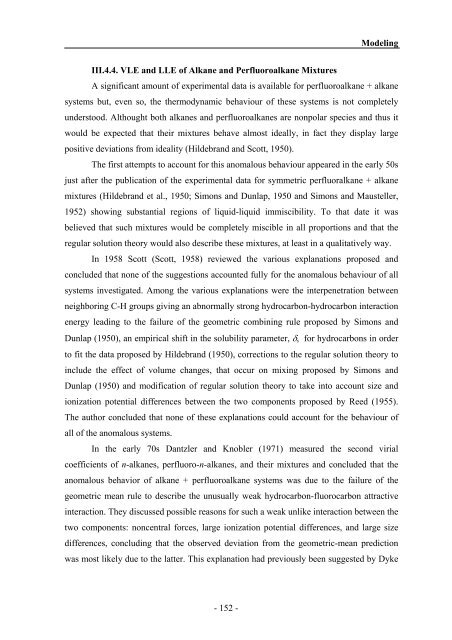n - PATh :.: Process and Product Applied Thermodynamics research ...
n - PATh :.: Process and Product Applied Thermodynamics research ...
n - PATh :.: Process and Product Applied Thermodynamics research ...
Create successful ePaper yourself
Turn your PDF publications into a flip-book with our unique Google optimized e-Paper software.
III.4.4. VLE <strong>and</strong> LLE of Alkane <strong>and</strong> Perfluoroalkane Mixtures<br />
Modeling<br />
A significant amount of experimental data is available for perfluoroalkane + alkane<br />
systems but, even so, the thermodynamic behaviour of these systems is not completely<br />
understood. Althought both alkanes <strong>and</strong> perfluoroalkanes are nonpolar species <strong>and</strong> thus it<br />
would be expected that their mixtures behave almost ideally, in fact they display large<br />
positive deviations from ideality (Hildebr<strong>and</strong> <strong>and</strong> Scott, 1950).<br />
The first attempts to account for this anomalous behaviour appeared in the early 50s<br />
just after the publication of the experimental data for symmetric perfluoralkane + alkane<br />
mixtures (Hildebr<strong>and</strong> et al., 1950; Simons <strong>and</strong> Dunlap, 1950 <strong>and</strong> Simons <strong>and</strong> Mausteller,<br />
1952) showing substantial regions of liquid-liquid immiscibility. To that date it was<br />
believed that such mixtures would be completely miscible in all proportions <strong>and</strong> that the<br />
regular solution theory would also describe these mixtures, at least in a qualitatively way.<br />
In 1958 Scott (Scott, 1958) reviewed the various explanations proposed <strong>and</strong><br />
concluded that none of the suggestions accounted fully for the anomalous behaviour of all<br />
systems investigated. Among the various explanations were the interpenetration between<br />
neighboring C-H groups giving an abnormally strong hydrocarbon-hydrocarbon interaction<br />
energy leading to the failure of the geometric combining rule proposed by Simons <strong>and</strong><br />
Dunlap (1950), an empirical shift in the solubility parameter, δ, for hydrocarbons in order<br />
to fit the data proposed by Hildebr<strong>and</strong> (1950), corrections to the regular solution theory to<br />
include the effect of volume changes, that occur on mixing proposed by Simons <strong>and</strong><br />
Dunlap (1950) <strong>and</strong> modification of regular solution theory to take into account size <strong>and</strong><br />
ionization potential differences between the two components proposed by Reed (1955).<br />
The author concluded that none of these explanations could account for the behaviour of<br />
all of the anomalous systems.<br />
In the early 70s Dantzler <strong>and</strong> Knobler (1971) measured the second virial<br />
coefficients of n-alkanes, perfluoro-n-alkanes, <strong>and</strong> their mixtures <strong>and</strong> concluded that the<br />
anomalous behavior of alkane + perfluoroalkane systems was due to the failure of the<br />
geometric mean rule to describe the unusually weak hydrocarbon-fluorocarbon attractive<br />
interaction. They discussed possible reasons for such a weak unlike interaction between the<br />
two components: noncentral forces, large ionization potential differences, <strong>and</strong> large size<br />
differences, concluding that the observed deviation from the geometric-mean prediction<br />
was most likely due to the latter. This explanation had previously been suggested by Dyke<br />
- 152 -



